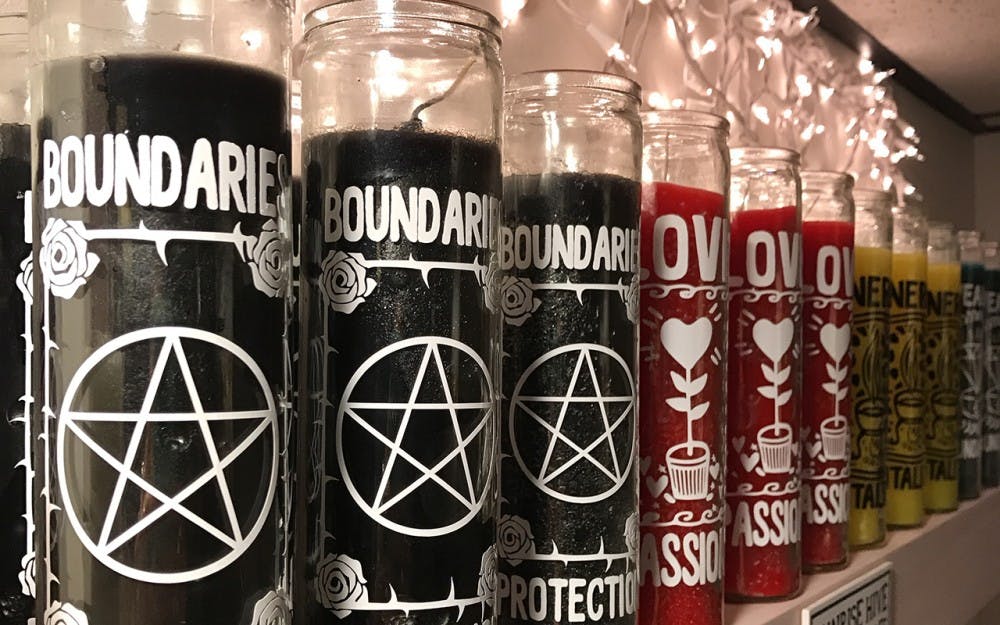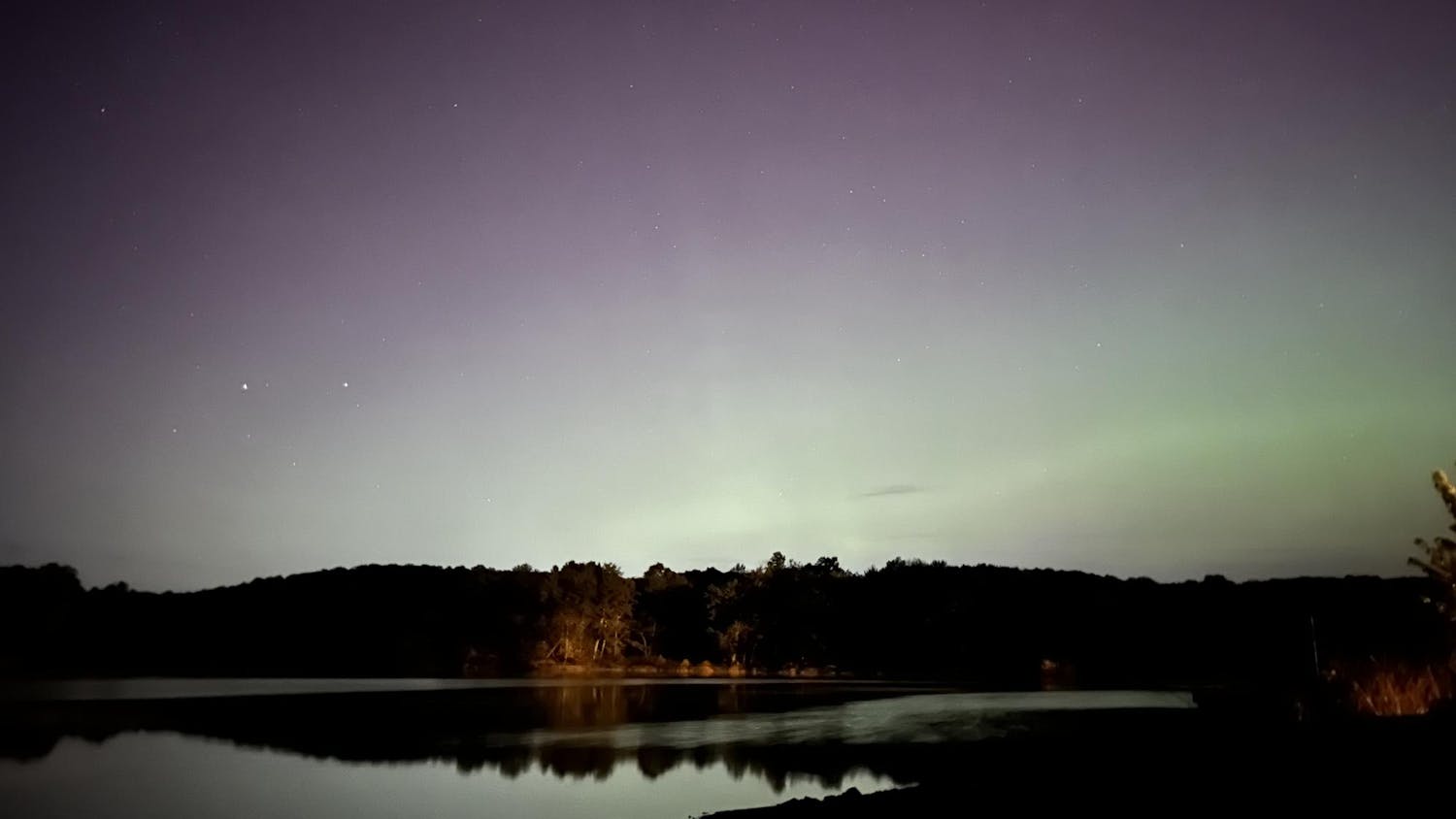Women gathered in a circle around a statue of Aphrodite. A hunk of rose quartz with a tea candle flickered on top. The women sipped tea, chatted and passed around tarot cards.
In the back, a banner with the words “Sunrise Hive” and an image of the sun hung among strings of fairy lights.
Daun Fields, who goes by the magical name Daun Evema, is the owner of Sunrise Hive, a business that offers tarot readings and workshops on goddess spirituality, magic and witchcraft. The Hive also serves as a gathering place for Bloomington’s witchcraft community.
For Evema, witchcraft is not just a hobby. It is her religion. She even calls the small room of Sunrise Hive her “tiny temple.”
“Through witchcraft, I see god as all of the energy that permeates everything,” she said. “It’s just the energy of life and the universe.”
Because she sees god as energy, she said god is also faceless and abstract. It also doesn’t have a gender, which is why she refers to god as the Great Goddess.
However, Evema said she studies individual goddesses with her coven. These goddesses are representations of the Great Goddess, she said. They attach a face to a faceless entity to make it easier for people to understand. A black-and-white picture of Evema’s favorite and the Hive’s patron goddess, the Norse goddess Freya, is mounted on the back wall of the Sunrise Hive storefront.
“They make that big, abstract energy more accessible and more understandable and tangible,” Evema said.
Bloomington resident Julia Zasada has been coming to Sunrise Hive since her first tarot reading two years ago. To her, witchcraft is more about spirituality rather than a religion with set dogmas and common beliefs, but she also sees parallels between witchcraft and conventional religions.
“With both, they involve specific practices,” Zasada said. “I guess witchcraft just isn’t as common throughout as other religions. It’s more eclectic and varied.”
Zasada said she grew up as a Catholic and the candles and incense involved in witchcraft remind her of her Catholic roots.
“They always say if you scratch a Catholic, there’s a pagan hidden underneath,” she said.
Evema said witchcraft also arises in her love of music. As a singer who dabbles in bass and guitar, Evema toured as a member of the punk band Door-keysfor 10 years. She said some of her strongest magical experiences involved dancing, sweating and moving along with the steady pulse of concert crowds.
“There’s a liberation in being able to be dirty and free and magical,” she said. “It’s just that human need to be primal and free.”
These experiences align with festivals and rituals worshiping Dionysus, the Greek god of wine, theater, and religious madness and ecstasy, she said. They also arise in her own experiences during rituals involving dancing naked around fires and burning effigies alongside around 100 people. While some witches regularly participate in these kinds of rituals, Evema said she and others at Sunrise Hive usually participate in tamer rituals.
But she said the experiences don’t involve evil or Satan-worshipping like in horror movies. Instead, they allow people the right to be primal.
“It’s primal communion,” she said. “It’s just throwing off the trappings of domesticity, of patriarchy and just being in the woods with people you love and trust.”
Some rituals involve black witch’s robes. Others include going skyclad, which means naked. However, most rituals just involve wearing normal clothes and sitting in circles with candles and incense, she said.
During these rituals, Evema said it’s not uncommon for there to be supernatural experiences like lights flickering or going out.
Once, Evema was leading a marriage blessing at night. The 30 participants lit candles and stood outside until a wind came and blew out every candle — all except her own.
Evema said she saw it as a blessing and a sign from the Great Goddess.
“When you get one of those signs, it feels really validating,” she said. “It feels like this energy outside of ourselves is real.”
Zasada said in these moments is when people are faced with a choice: to believe in the sign or to see it as a coincidence.
When practicing magic during these rituals, Evema said it starts with breathing and focusing the mind, often through chanting or spells. Next, witches practice connecting to and moving energy.
Evema often moves this energy to a focal point like an altar, candle, stone or incense by focusing her mind on these objects and visualizing the energy moving, she said.
She said focusing on a certain point while thinking about a goal is how you do magic.
This magic doesn’t create fireballs or allow witches to levitate like it does in the movies, Evema said. Instead, those images in movies are physical representations of what goes on in a witch’s mind. There may not be a fireball in the air, but the witch may feel it and visualize it, she said.
Evema said she recalls times where those in her circle felt the presence of a deity or goddess. While outsiders wouldn’t be able to see a deity with deer horns walking around the room, the participants could all feel her and visualize her.
While most representations of magic in the media are merely symbolic, Evema said some magic can bring about physical effects. For example, she has often passed an orb around a circle from hand to hand as participants tried to warm it up. She said you could feel the orb getting warmer as it was passed along.
Above all, the purpose of this magic is to connect with others and natural energy through the elements — earth, fire, air and water — she said. It is not to worship Satan, and it does not involve sacrificing animals or babies.
“Witchcraft respects life,” she said. “We’d never kill anything, despite those stereotypes.”
She said people often ask her what it’s like to be out of the “broom closet.” She said she isn’t worried about the stereotype of evil, wart-covered, green-nosed witches. Instead, it is when people see witchcraft as a silly fantasy that hits close to home.
“It’s my religion,” Evema said. “It’s who I am.”
Above all, Zasada said witchcraft involves a thriving and welcoming community in Bloomington. She said the women who gather at Sunrise Hive respect, challenge and learn from one another. Witchcraft ties them all together.
“We’re open to everyone,” she said. “And I promise you, no babies will be served here.”






